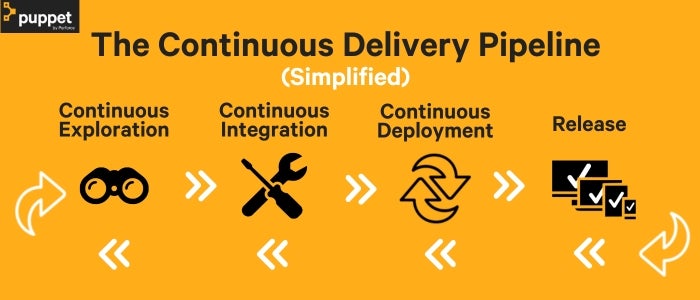Blog
October 25, 2023
What is Continuous Delivery? The Benefits of a Well-Tuned Continuous Delivery Software Pipeline
DevOps,
Products & Services
What is continuous delivery? And what are the benefits of the continuous delivery pipeline? This strategy has evolved in a world where platform engineering is on the rise and more and more organizations rely on automation through code to achieve their goals.
Times have changed. Most organizations now rely on continuous delivery as an essential part of their development pipelines. By automating every stage of the delivery process, IT operations teams are able to make updates swiftly and accurately while significantly reducing the potential for errors.
Read on to learn more about the benefits of continuous software delivery and how IT automation tools from Puppet can help.
Table of Contents:
- What is Continuous Delivery?
- What is the Continuous Delivery Pipeline?
- What is Continuous Delivery vs. Continuous Deployment
- What are the Benefits of Continuous Software Delivery?
- An Example of Continuous Software Delivery at Work
- Continuous Software Delivery with Puppet Enterprise
What is Continuous Delivery?
Continuous delivery is a software development practice that automates and streamlines the software delivery process, ensuring that new versions of code are always ready for deployment and can be quickly and reliably delivered to customers.
This practice minimizes the manual intervention required in the software delivery process, helping to reduce the number of errors and making it possible to deliver new code more quickly. It also allows for more efficient development and testing, ensuring that software is ready at every stage of the development lifecycle.
What is the Continuous Delivery Pipeline?
A continuous delivery pipeline is a set of automated steps that move new software from development to production quickly and reliably. It builds, tests, and deploys code in a single workflow, so teams can deliver value to customers more often.
The continuous delivery pipeline typically consists of four key steps:
- Continuous exploration: Defining the software to be built or features to be added, researching the needs of its users, and structuring features.
- Continuous integration (CI): Building and testing the code that contains new features, then pushing them to a staging environment.
- Continuous deployment (CD): Pushing code changes from the staging environment and deploying them to production.
- Release: Making the software available to customers.
At the 'end' of the pipeline, the cycle starts again (hence "continuous"). Customers or users get their hands on the newly released or updated software and generate feedback metrics that can be collected and used to plan new features in the exploration stage.

You might think of the pipeline as the steps involved along the way when you are implementing continuous software delivery. It includes the entire end-to-end process of development, testing, and delivery.
What is Continuous Delivery vs. Continuous Deployment
The primary difference between continuous delivery and continuous deployment is the extra step to approve updates before pushing to production.
Continuous delivery automates the process of pushing new code to a non-production environment such as a staging or testing server. This allows developers to complete tasks like integration and performance testing in a safe environment prior to releasing the code to the public.
Continuous deployment takes this process one step further and automates the deployment of the application to production. This means that once the code has passed through the development pipeline and all tests have been successfully completed, the code is automatically deployed to the production environment.
Both of these processes are important components of your automated workflow, as they allow for rapid, efficient development.
What Are the Benefits of Continuous Software Delivery?
When it’s well executed, continuous delivery allows an organization to respond more quickly to its market and customers, both internal and external. It also makes life saner for people in IT operations, software development, and quality testing teams.
Instead of long periods of development punctuated by looming deadlines, big dramatic releases, and panicked remediation of serious bugs, software releases are small, predictable, and less dramatic… even boring.
Here are a few of top benefits of continuous delivery:
A key element of platform engineering
The platform engineering philosophy is about examining the entire software delivery workflow and enabling self-service. This means that developers are empowered to act without requiring additional help or approval from other departments.
Continuous delivery enables platform engineering — both enable continuous software delivery. They give teams the tools they need to deploy without downtime, with greater collaboration, and with fewer roadblocks. You can’t have one without the other. If you’re carefully building a platform and thinking through each step of software delivery, but you’re not trying to make delivery more efficient, then that work is wasted.
Removes bottlenecks
Building on the principles of platform engineering with self-service at the core, continuous delivery supports this overall philosophy and removes the bottlenecks that can occur when unnecessary stakeholders or steps slow down the process of continuous software delivery.
Bottlenecks can be caused by issue that continuous delivery can help with, like:
- Manual, error-prone processes — Tasks like manual testing can eat up time within your software delivery pipeline, and that is only one step within the larger process. Where are you exerting manual time, when you could be relying on code to do the heavy lifting for you
- Communication missteps — A lot can go wrong between different stakeholders along the software delivery pipeline. Continuous software delivery provides the chance to “set it and forget it,” once you’ve agreed and established code, that process can continue to deliver automatically without additional manual steps and communication or approvals.
- Slowed production — Let’s say you’ve established a certain time frame for a project to be completed. If you can’t accurately determine how long it will take for code to be tested or reviewed, those added steps can stretch your original goal and lead to slower production.
Only needs to be as “continuous” as you want
When you’re in control of code, you’re also in control of how much or little continuous software delivery is used across your pipeline. Want to manage certain patches or updates for specific software yourself? Do you have compliance regulations or other requirements that need to be manually reviewed? Continuous software delivery doesn’t need to be all or nothing.
Improved compliance & security
Continuous software delivery is a clear choice for compliance implementation — but how can it support overall security? With code, you can do accomplish tasks like running a security scan, deploying code to secure environments (like those that are isolated from public internet), and you can also implement control measures like role-based access control. When a strong security plan and continuous delivery meet, compliance and security are hardened.
Deliver software with fewer bugs and lower risk
When you release smaller changes more frequently, you catch errors much earlier in the development process. When you implement automated testing at every stage of development, you don’t pass failed code to the next stage. And it’s easier to roll back smaller changes when you need to.
Release new features to market more frequently — and learn
Releasing new features early and often — even in a minimally viable state — means you get more frequent feedback, giving you the ability to iterate and learn from your customers. Enlisting customers as development partners gives them a sense of co-ownership and loyalty and makes them more likely to forgive when you stumble.
Respond to market conditions more quickly.
Market conditions change constantly. Whether you’ve just discovered a new product is losing money or that more customers are visiting your site from smartphones than laptops, it’s much easier to make a fast change if you are already practicing continuous delivery.
Life is saner for everyone: IT operations, software development, QA, product owners, and business line owners
Continuous delivery means the responsibility for software delivery is distributed much more widely, and this shared responsibility and collaboration make life better. It also takes a lot of stress out of software release. Releasing smaller changes more often gets everyone used to a regular, predictable pace, leaving room to come up with ideas and actually enjoy your work. Best of all, a successful release becomes a shared success, one you can all celebrate together.
An Example of Continuous Software Delivery at Work
Continuous Delivery Pipeline Example:
Let’s use an example of an online retailer, Company X, that sells directly to consumers using an online storefront. Since they started small and started to scale with growth, their software delivery process was slow and inefficient. Because so much of it was manual, it could take weeks or even months to fix bugs and release new features. This was an issue for the business (they couldn’t keep up with internal requests) and the customers (user experience on the site suffered with outdated, buggy UX).
The solution? A continuous delivery pipeline was put into place for Company X.
This automated the entire software delivery process, including production deployment. Automated testing was also used to make sure that code changes were tested before being deployed into production. This sped up delivery time to days, even hours. If something needed to be updated or changed on the website, if patches needed to be applied, if a security check needed to run — everything was covered in the continuous delivery pipeline.
Continuous Delivery for Patching Example:
Customer Y had a manual patching process that was eating up their team’s valuable time. They needed to automate their processes to streamline and be able to keep up with business goals.
With continuous delivery patching, they were able to set up their patching changes to go through their different environments, dev, test, and prod. Their changes automatically go to the next stage if they pass and stop the deployment if it fails.
They are now able to run patching through impact analysis if using CD4PE to understand if there might be any unintentional changes. If everything runs smoothly through the pipeline, it can automatically be promoted to production — they can make this process as continuous as they prefer.
In this case, Customer Y decided to auto promote patches to production with an additional approval step in between. This meant that they still maintained visibility, even while patches were continuously rolled out.
Because of this, their team was able to spend more time on things that mattered — simply approving for visibility rather than managing the patch through each environment.
Continuous Software Delivery with Puppet Enterprise
There are a lot of different continuous delivery tools to choose from. With the right tool, you can maximize the agility and productivity of your development and operations teams and support platform engineering goals across your org.
Puppet Enterprise has helped 40,000+ companies automate all stages of the software development workflow, from continuous integration to deployment. It provides a comprehensive set of tools for monitoring and managing software releases, allowing teams to track their progress and make changes quickly and easily.
Continuous Delivery for Puppet Enterprise is Puppet’s CI/CD tool that makes it easy to create repeatable, reliable, and secure pipelines for delivering applications and infrastructure changes. It enables Dev and Ops teams to quickly and accurately deploy changes, reduce time-to-market, and maintain quality and stability of their deployments.
When you’re ready to deploy, the Impact Analysis function assesses proposed Puppet code changes and reports the servers and configurations in a target environment that will be affected should the code change be deployed.
Don’t just take our word for it — discover the benefits of Continuous Delivery for Puppet Enterprise for yourself. Get up and running with a free trial today.
